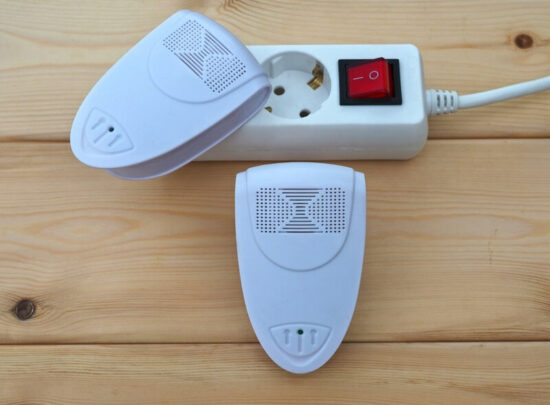Ultrasonic pest repellers are an attractive hands-off option for many homeowners. But understandably, many potential buyers want to know if these devices will bother their dog.
This guide will cover if ultrasonic pest repellers are safe for dogs as well as signs that it might be affecting them.
Table of Contents
What Are Ultrasonic Pest Repellers?
You might have seen ultrasonic pest repellers at your local home improvement store or on television. These products are relatively new and currently enjoying some time in the limelight.
But what exactly are they?
Ultrasonic repellers are small devices that emit high-frequency sound waves. The sound waves are high-frequency but have a shorter wavelength. The devices operate out of the range of human hearing, so you can’t hear them when they’re on.
No products found.
The concept behind ultrasonic repellers is simple: They produce sound waves that are inaudible to humans but mind-numbingly annoying to pests. Manufacturers claim these little devices can keep rodents like mice and rats away. They may also repel some insects and other living creatures.
The jury is still out about how reliable these devices are. However, many homeowners have seen great success using them.
Because they rely on sound alone to keep pests out, many view them as a safer alternative to chemical pesticides and other potentially dangerous extermination methods.
Are Ultrasonic Pest Repellers Safe For Dogs?
Ultrasonic pest repellers are impressive devices and a feat of modern technology. But there is one question that many pet owners have:
Are ultrasonic pest repellers safe for dogs?
Ultrasonic devices operate beyond the range of human hearing. But that doesn’t mean that your dogs can’t hear them.
Humans can hear sounds between 20 Hz and 20 kHz. That’s the average, but many adults lose their ability to hear the upper frequencies as they age. As a result, the higher end of the spectrum is usually closer to 16 or 17 kHz.
Meanwhile, dogs have a ranger of about 40 Hz to 60 kHz. They can hear much higher frequencies than humans do. Not only that, but their ears are more sensitive.
If you own a dog, you’ve likely experienced a situation where they detected something long before you did. Maybe they heard someone walking up to your door or a distant car horn. Whatever the case might be, it only goes to show that canines have sensitive ears that surpass the capabilities of humans.
Therein lies the issue. Ultrasonic pest repellers can operate anywhere above 20 kHz. Models can vary in frequency and intensity. However, most fall somewhere between 20 kHz and 60 kHz.
That’s far above what humans can hear, so we’re unbothered when these devices function correctly. But that range is still within what dogs can listen to.
The concern is that the noise causes distress and long-term damage. To be effective, you must keep ultrasonic pest repellers on around the clock. There’s no turning them off and on.
Again, that’s no issue for humans. But for dogs and other pets, it can be annoying listening to that sound non-stop.
Some animal experts say that over-exposure to high-pitched sounds can cause neurological disorders in dogs. It’s akin to a human dealing with tinnitus, so the argument is that it’s enough to drive dogs mad!
But is that true?
Thankfully, there’s no evidence to support the claim that ultrasonic pest repellers are not safe for dogs (or will cause long-term neurological damage). Dog owners have observed that some animals are more sensitive to these devices than others, but there’s no proof that they can cause any serious health issues.
Why It’s Important To Watch Your Dog After You Set Up The Repeller
While ultrasonic pest repellers are considered safe for dogs, that doesn’t necessarily mean it’s the right choice for you and your home. Certain dogs can still react negatively to those sound waves that we can’t hear. It might not be dangerous, but your dog can still be bothered and suffer in silence!
Have you ever used a dog whistle? They’re pretty standard in the world of dog training. Trainers will use these whistles to capture a dog’s attention and give commands.
You might hear a faint hum when you use these whistles, but they’re mainly out of the range of human hearing. The effect of an ultrasonic pest repeller is akin to a dog whistle.
No products found.
It’s jarring enough to grab their attention and too annoying to ignore.
Not all dogs will react negatively. It all depends on the type of repeller you use and your pup’s sensitivities. Because there are so many variables at play, you must keep a close eye on your dog and its reaction after setting up the repeller.
After turning it on, your dog may or may not react to it right off the bat. There are a few telltale signs that your dog can hear the ultrasonic sound waves.
The most obvious is that they turn their attention to the repeller. To your precious pup, the sound is a significant source of confusion! As a result, they may cock their head to the side and push their ears back.

If your dog has pointy ears, they may move in the general direction of the repeller. Some dogs will go so far as to look for the noise source. They know it’s around there somewhere, but they have no idea what’s making it.
Your dog will likely look surprised and confused. That’s normal. In some cases, dogs can look pretty intense, too.
Some canines maintain a tight jaw, push their ears back, move their tail in a specific direction, and look intently around the room. This behavior is usually benign, but exercising caution is always a good idea. Even the most well-behaved and well-trained dog can act unpredictably when exposed to unique experiences like an ultrasonic pest repeller (especially for extended periods of time).
All of the signs we’ve discussed thus far are normal. They show that your dog does indeed hear the noise, but it doesn’t necessarily mean that they’re bothered by it.
Continue to keep an eye on your furry friend’s behavior. Ideally, they will calm down and ignore the noise after a few minutes. In most cases, the initial shock of the sound causes a reaction. As they get used to the noise, they might tune it out.
However, some dogs will continue to experience distress. This is when you need to take action and remove the ultrasonic pest repeller.
As mentioned earlier, there isn’t any scientific evidence to say it’s unsafe. But the sound can be alarming enough to affect your dog and the way they act. Your home is supposed to be a comfortable place for you and your pet, so it’s a good idea to eliminate the issue if it causes ongoing problems.
How can you tell that your dog is bothered by the ultrasonic sound?
The first sign is that their oddball behavior persists. Instead of relaxing and ignoring the sound, they continue to act strangely. They may stay alert for several hours or continue to search your home for the source of the sound.
That indicates that the dog is trying its best to find and eliminate the source.
Keep an eye on their movements and breathing. Agitated dogs might start to pace around the room, walk from side to side, and breathe heavily.
General nervousness is also a common sign. Dogs who don’t like the ultrasonic noise may begin to whine or bark out of nowhere. It’s their way of telling you to stop whatever is creating the sound.
In extreme cases, dogs can get downright terrified! When that happens, a dog might go to you for protection, start shaking violently, and show symptoms of anxiety.
All of those signs should raise a red flag. If you notice that your dog is clearly bothered by the ultrasonic pest repeller, it’s best to look for other pest control alternatives (there are plenty of options out there). Never ignore your dog’s discomfort. You never know what kinds of issues that could cause later!
Best Locations For Ultrasonic Pest Repellers If You Own A Dog
If your dog isn’t too bothered by the ultrasonic pest repeller, you can continue using it. But even still, it’s better to place it strategically to avoid its effects on your precious dog.
So, where do you put it?
Of course, you should keep the repeller in the area where you spotted the pest. Maybe you encountered a rodent scurrying past your feet in a specific room, indicating that there’s a pest access point somewhere.
Place the repeller in the area where you’ve seen the pest and do your best to keep your dog out. The ultrasonic sounds can’t penetrate through solid surfaces very well. As a result, your dog won’t be able to hear much of it if you close the room and keep them out.
Another important tip is to use multiple repellers. Because ultrasonic sound waves are so delicate, they can’t get past furniture and walls. Using numerous devices ensures that you’re getting maximum coverage.
Many pest control experts also recommend using other methods. While these devices can be effective, relying on them alone is not wise. Consider setting up traps and baits to eradicate the pests for good.
Can Dogs Hear Ultrasonic Pest Repellers?
As we’ve covered, dogs can hear ultrasonic pest repellers. However, the way this impacts them will depend on the dog as well as the frequency of the device.
It’s rather common to see dogs react to the repeller (even though it’s safe for them), and this is because they can hear it.
While humans can’t hear ultrasonic pest repellers, the more sensitive ears of a dog will often have no problem picking up the sound. It’s how they react that matters!
Conclusion
Ultrasonic pest repellers are safe for dogs, but that doesn’t always mean they’re a great choice for your home. Depending on the situation and the behavior of your dog, you might have to consider other options.
Fortunately, there are plenty of alternative methods you can consider. Just keep an eye on your dog’s behavior and let that be your guide!


